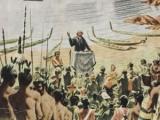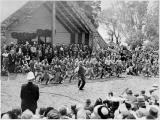Darwin's visit to the Bay of Islands on HMS Beagle was brief and unspectacular from his point of view. The Beagle's captain, Robert FitzRoy, would later serve as the second governor of New Zealand.
Pre-1840 Contact
Events In History
The family of the whaler Jacky Guard were among a group of Pākehā captured by Māori in May 1834 after the barque Harriet ran aground on the Taranaki coast.
Articles
Sealers and whalers

A European population explosion first impacted on New Zealand in the closing decade of the 18th century when sealers and whalers began to arrive in their hundreds seeking to exploit local resources. Read the full article
Page 1 - Sealers and whalers
A European population explosion first impacted on New Zealand in the closing decade of the 18th century when sealers and whalers began to arrive in their hundreds seeking to
A frontier of chaos?

In the years before the signing of the Treaty of Waitangi, relations between Māori and Europeans were marred by a number of high-profile incidents. Read the full article
Page 1 - Frontier of chaos?
In the years before the signing of the Treaty of Waitangi, relations between Māori and Europeans were marred by a number of high-profile
Page 2 - Overview
The experiences of the explorers Abel Tasman, James Cook and Marion du Fresne convinced many Europeans that New Zealand was a dangerous
Page 3 - Māori values and practices
Māori responses in the early contact period were determined by well-established customs and
Page 4 - The Boyd incident
In December 1809 the sailing ship Boyd was anchored in Whangaroa Harbour. It was attacked by a group of Māori who killed most of its crew and passengers in retaliation for the
Page 5 - Captain Stewart and the Elizabeth
In 1830 Captain William Stewart of the brig Elizabeth made an arrangement with the Ngāti Toa leader Te Rauparaha to ferry a taua (war party) of 100 warriors from his base on
Page 6 - The Harriet affair
The rescue of Betty Guard and her two children from Ngāti Ruanui in the spring of 1834 involved the first use of British troops on New Zealand soil.
Page 7 - Kororāreka
The missionaries divided the Europeans who came to New Zealand in the early 19th century into two groups: the agents of virtue (themselves) and the agents of vice (almost everyone
Page 8 - Further information
Links and publications relating to case studies of Māori–Pākehā clashes before the signing of the Treaty of Waitangi
Go-betweens
An important feature of early cross-cultural contact in New Zealand was the role of intermediaries (kaiwhakarite) who acted as go-betweens – people from one culture who lived within the other culture and helped bridge the gap between the two. Read the full article
Page 1 - The go-betweens
An important feature of early cross-cultural contact in New Zealand was the role of intermediaries (kaiwhakarite) who acted as go-betweens – people from one culture who lived
Page 2 - Pākehā-Māori
Europeans who settled in Māori communities and adopted a Māori lifestyle were described as 'Pākehā-Māori'
Page 3 - Māori intermediaries: Ruatara
In 1805 the Ngāpuhi chief Ruatara left New Zealand on the whaling ship Argo with the intention of meeting King George
Page 4 - The first woman settler?
Charlotte Badger is believed to have been one of the first two European women to live (albeit briefly) in New
Page 5 - Further information
Publications and links relating to Pakeha-Maori and Maori-Pakeha in the pre-1840 period
Missionaries

The Christian missionaries of the pre-1840s have been described as the 'agents of virtue in a world of vice', although they were not immune to moral blemish themselves. Read the full article
Page 1 - The Christian missionaries
The Christian missionaries of the pre-1840s have been described as the 'agents of virtue in a world of vice', although they were not immune to moral blemish themselves.
Page 2 - Establishing the Church Missionary Society
Samuel Marsden was a key figure in the establishment of the first Christian mission in New Zealand.
Page 3 - Men of vice or virtue?
Thomas Kendall established the first mission school, but he was later suspended after admitting an adulterous affair with a Maori
Page 4 - Fixing God's house
Henry Williams, who had been ordained a priest in 1822 'for the cure of souls in his majesty's foreign possessions', inherited a mission beset by
Page 5 - Wesleyans and Catholics
How Maori responded to the arrival of Wesleyan and Catholic missionaries in the Bay of
Page 6 - Printing the word of God
From the mid-1830s the printed word became a new weapon in the campaign to bring Christianity to
Page 7 - Further information
Publications and links with information about pre-1840 missionaries
Taming the frontier

In 1832 James Busby was appointed as the official British Resident to New Zealand. After arriving in the Bay of Islands in May 1833 he took steps to tame what he saw as a chaotic frontier society. Read the full article
Page 1 - Taming the pre-1840 frontier
In 1832 James Busby was appointed as the official British Resident to New Zealand. After arriving in the Bay of Islands in May 1833 he took steps to tame what he saw as a chaotic
Page 2 - New South Wales and New Zealand
By the early 1830s humanitarians were encouraging the British government to take a more active role in New Zealand
Page 3 - Choosing a flag
The selection of the flag of the United Tribes of New Zealand as New Zealand's first flag
Page 4 - Land issues on the eve of the Treaty of Waitangi
In the late 1830s the British government became concerned about how land was being obtained from Māori. Action was needed, it decided, to protect Māori from the worst ravages of
Page 5 - A separate Crown colony
Protecting Māori, regulating land purchases, controlling the activities of settlers and dealing with the potential influx of migrants underpinned British policy in 1839. New
Page 6 - Further information
Links and further information relating to the first New Zealand flag and the Declaration of
Treaty timeline

See some of the key events between 1800 and 1849 relating to the Treaty of Waitangi. Read the full article
Page 1 - Treaty events 1800-49
See some of the key events between 1800 and 1849 relating to the Treaty of Waitangi.
A history of New Zealand 1769-1914
In the period between the first European landings and the First World War, Aotearoa New Zealand was transformed from an exclusively Māori world into one in which Pākehā dominated numerically, politically, socially and economically. Read the full article
Page 1 - History of New Zealand, 1769-1914
In the period between the first European landings and the First World War, Aotearoa New Zealand was transformed from an exclusively Māori world into one in which Pākehā dominated
He Whakaputanga - Declaration of Independence
On 28 October 1835, 34 rangatira signed He Whakaputanga o te Rangatiratanga o Nu Tireni (the Declaration of Independence of the United Tribes of New Zealand). Read the full article
Page 1 - Declaration of Independence
On 28 October 1835, 34 rangatira signed He Whakaputanga o te Rangatiratanga o Nu Tireni (the Declaration of Independence of the United Tribes of New
Page 2 - Further information
Further reading relating to He Whakaputanga - the Declaration of
Encounters
It was only around 3000 years ago that people began heading eastwards from New Guinea and Solomon Islands into the Pacific Ocean. Read the full article
Page 2 - European voyaging and discovery
Portuguese and Spanish navigators sailed the Pacific Ocean in the 1500s, but there is no firm evidence that Europeans reached New Zealand before 1642 when the Dutch explorer Abel
Page 3 - Early meetings between peoples
James Cook’s relationship with Māori got off to a disastrous start when a Ngāti Oneone leader, Te Maro, was shot and killed in a confused encounter. Misunderstandings led to

















